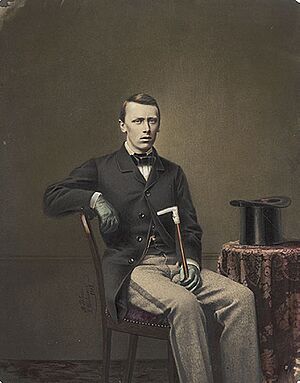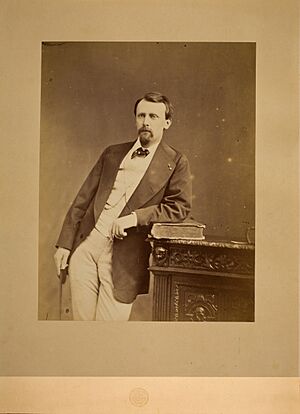William, Prince of Orange facts for kids
Quick facts for kids William |
|||||
|---|---|---|---|---|---|
| Prince of Orange | |||||
 |
|||||
| Born | 4 September 1840 Noordeinde Palace, The Hague, Netherlands |
||||
| Died | 11 June 1879 (aged 38) Paris, France |
||||
| Burial | 26 June 1879 Nieuwe Kerk, Delft, Netherlands |
||||
|
|||||
| House | Orange-Nassau | ||||
| Father | William III of the Netherlands | ||||
| Mother | Sophie of Württemberg | ||||
William, Prince of Orange (born Willem Nicolaas Alexander Frederik Karel Hendrik; 4 September 1840 – 11 June 1879), was the heir apparent to the Dutch throne. He was the oldest son of King William III. William was the heir from 17 March 1849 until he passed away.
Early Life of Prince William
Prince William was the first son of William III of the Netherlands, who was King, and his first wife, Princess Sophie of Württemberg. People often called him Wiwill. When he was born, he was third in line to become the next ruler of the Netherlands. He was also seventeenth in line for the British throne. This was because of his mother's great-grandmother, Princess Augusta of Great Britain.
Just one month after William was born, on 7 October 1840, his great-grandfather, King William I of the Netherlands, stepped down from the throne. This happened because he was unhappy with the Treaty of London. This treaty recognized Belgium as an independent country. Belgium used to be part of the United Kingdom of the Netherlands. In 1849, after his grandfather King William II of the Netherlands died, William became the Prince of Orange. This title meant he was the next in line to be King. His strict upbringing, common in the Victorian era, was quite difficult for him.
Challenges with Marriage
There were plans for Prince William to marry Princess Alice of the United Kingdom. She was the second daughter of Queen Victoria. However, these plans did not work out. Later, in 1873, the prince fell in love with Countess Mathilde von Limburg-Stirum. She was 19 years old at the time.
William's relationship with his parents became very difficult. His parents did not approve of him marrying Mathilde in 1874. For the Dutch royal family, marrying someone from the nobility was seen as unequal. This meant it was not acceptable for a royal. William, who was 33, wanted to marry Mathilde even without his parents' permission. But Mathilde was not yet 20, so she needed her parents' permission too. Her parents also said no. Because of this, William's plan to marry Mathilde failed. She later married Baron Reginald van Tuyll in 1881. Mathilde passed away on 14 May 1932, at the age of 77, in England.
Later Life and Passing
Prince William felt very disappointed with his life in the Netherlands. He decided to move to Paris, France. He died there at the age of 38. His apartment was on Rue Auber, close to the Paris Opera. On 26 June 1879, his body was placed in the royal crypt at the New Church of Delft. A wreath from the French Empress Eugénie de Montijo was placed on his coffin. Another wreath came from the future King Edward VII of the United Kingdom.
After William's death, his younger brother Alexander became the next heir. He also received the title of Prince of Orange. However, Alexander also died before their father, King William III. This meant the King no longer had any sons. In 1888, the Dutch Parliament changed the rules for who could inherit the throne. They adopted cognatic primogeniture. This meant that daughters could also inherit the throne if there were no sons.
Royal Honours
 Belgium: Grand Cordon of the Order of Leopold (civil), given on 21 October 1861
Belgium: Grand Cordon of the Order of Leopold (civil), given on 21 October 1861


